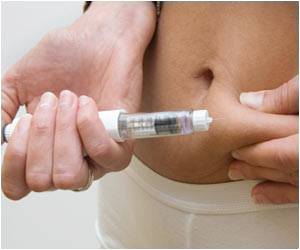New pill helps deliver insulin orally. The capsule is fitted with a tiny needle, coated with insulin, which is injected into the stomach wall. This could replace the need for injections in the future.
- A new pill has been developed that can deliver insulin orally
- The capsule is fitted with a tiny needle, coated with insulin, which can be injected into the stomach wall
- This discovery could revolutionize the way insulin is delivered and could replace injections in the future
The study was jointly led by Dr. Robert S. Langer, ScD, FREng and Dr. Giovanni Traverso, MB, BChir, Ph.D.
Dr. Langer is the David H. Koch Institute Professor at the Department of Chemical Engineering, MIT, Cambridge, Massachusetts, USA.
Dr. Traverso is an Associate Physician at Brigham and Women’s Hospital and an Assistant Professor at Harvard Medical School. He is also a Visiting Scientist at MIT’s Department of Mechanical Engineering, Massachusetts, USA.
The first author of the paper is Alex Abramson, a graduate student at MIT. The research team also includes scientists from Novo Nordisk, the Danish multinational pharmaceutical company, headquartered in Bagsværd, Denmark.
The study has been published in Science, the prestigious journal of the American Association for the Advancement of Science (AAAS).
Read More..
How was the Device Conceptualized?
A unique feature of the capsule is that no matter what state the body is in, it has the ability to orient itself so that the needle-side always faces the stomach wall, enabling efficient injection of the drug. This self-orientation property of the capsule was inspired by a tortoise known as the leopard tortoise, which is found in Africa.The shell of this tortoise is quite high and dome-shaped so that if it rolls over upside-down, it can roll back again in the original orientation with ease. The researchers used computer modeling to design the capsule so as to mimic the self-orientation property of the tortoise. This enables the capsule to re-orient itself, even in the dynamic and turbulent environment of the stomach.
“What’s important is that we have the needle in contact with the tissue when it is injected,” Abramson says. “Also, if a person were to move around or the stomach was to growl, the device would not move from its preferred orientation.”
How was the Device Fabricated?
The new capsule is based on a previous capsule developed by Langer’s group, which had many tiny needles protruding from its surface for injecting drugs into the lining of the stomach or the small intestine.The previous capsule was redesigned so that the new version has just one needle. This prevents injection of the drugs contained in the capsule into the stomach contents, where they would be immediately inactivated and degraded by the stomach acid, before producing any effect.
The tip of the needle constitutes 100 percent freeze-dried, compressed insulin, which is made by a similar method used for making tablets. The shaft of the needle, made of a biodegradable material, does not enter the stomach wall during the injection process.
How is the Insulin Delivered?
The insulin is injected by a spring-like mechanism. In the capsule, the needle is kept in place by a disk made of sugar. After swallowing, the capsule enters the stomach and the sugar disk gets dissolved, releasing the spring, which rapidly ejects the needle tip into the stomach wall, injecting the insulin. Since the capsule can self-orient itself, the injection takes place only when the needle-side of the capsule is juxtaposed with the wall of the stomach. Importantly, since the stomach wall lacks pain receptors, the patient will not feel any pain during injection.What Happens After Insulin Delivery?
Following injection into the stomach wall, the insulin dissolves and enters the bloodstream. The rate of dissolving is dependent on the way the compressed insulin is incorporated into the needle tip at the time of fabrication of the capsule. In the present study, it took roughly one hour for the insulin to completely dissolve and enter the bloodstream.After releasing its contents, the capsule passes down the gastrointestinal (GI) tract and is excreted out along with the feces. Since the capsule is made of biodegradable material and tiny stainless steel components, it does not produce any adverse effects in the GI tract.
Initial studies in pigs showed that it was possible to deliver up to 300 micrograms of insulin, but recent studies have shown that the dose can be increased to 5 milligrams. This latter dose is equivalent to the standard dose that a diabetic patient needs to inject.
Future Plans
The MIT researchers are in the process of further developing the technology in collaboration with Novo Nordisk. They are planning to streamline the manufacturing process so that the capsules can be produced in large quantities for carrying out clinical studies in humans. The research team is optimistic that the device will not only be useful for insulin delivery, but also for delivering other protein-based drugs such as immunosuppressants, which need to be injected. Moreover, the research team believes that nucleic acids such as DNA (deoxyribonucleic acid) and RNA (ribonucleic acid) could also be safely delivered by the capsule device.Expert Comments
“Our motivation is to make it easier for patients to take medication, particularly medications that require an injection,” Traverso says. “The classic one is insulin, but there are many others.”“We are really hopeful that this new type of capsule could someday help diabetic patients and perhaps anyone who requires therapies that can now only be given by injection or infusion,” says Langer.
Funding Source
The study was funded by the National Institutes of Health (NIH), Novo Nordisk, Brigham and Women’s Hospital, MIT Undergraduate Research Opportunities Program, and two research scholarships.Reference:
- An Ingestible Self-orienting System for Oral Delivery of Macromolecules - (http://science.sciencemag.org/content/363/6427/611)
Source-Medindia
















